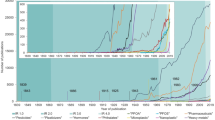Abstract
The use of exhaled breath as a biological monitoring tool is still not widely used. Although there are now commercially available kits, there are limited data on biological guidance values for all but a few substances for breath monitoring. The study investigated the possibility of using an indirect breath sampler to measure the levels of nitrous oxide in the exhaled breath of midwives at a midpoint during their shift. Levels of nitrous oxide in the exhaled breath were measured at (0–727 ppm) with a mean level of 64 ppm. The correlation between the established personal environmental monitoring and exhaled breath monitoring was generally poor as was the correlation between duration of nitrous oxide exposure and levels in the exhaled breath. Clearly the use of exhaled breath as a tool for biological monitoring is more appropriate than other invasive procedures. The breath sampler used has been a readily acceptable tool for occupational hygiene monitoring in a busy hospital ward.
This is a preview of subscription content, access via your institution
Access options
Subscribe to this journal
Receive 6 print issues and online access
$259.00 per year
only $43.17 per issue
Buy this article
- Purchase on Springer Link
- Instant access to full article PDF
Prices may be subject to local taxes which are calculated during checkout



Similar content being viewed by others
References
Baird PA . Occupational exposure to nitrous oxide — not a laughing matter, N Engl J Med (1992) 327 (14): 1026–1027
Dyne D Cocker J Wilson HK . A Novel device for capturing breath samples for solvent analysis, Sci Total Environ (1997) 199: 83–89
Erikson A Kallen B . Survey of infants born in 1973 or 1975 to Swedish women working in operating rooms during their pregnancies, Anaesth Analg (1979) 58: 302
Erikson A Kallen B . Hospitalisation for miscarriage and delivery room outcome among Swedish nurses working in operating rooms 1973–1978, Anaesth Analg (1985) 64: 981
Guirguis SS Pelmear PL Roy ML Wong L . Health effects associated with exposure to anaesthetic gases in Ontario hospital personnel, Br J Occup Med (1990) 47 7 490–497
Harrington JM . The health of Anaesthetists, Anaesthesia (1987) 42: 131–132
Hemminki K Kyyronen P Lindbohm ML . Spontaneous abortions and malformations in the offspring of nurses exposed to anaesthetic gases, cytotoxic drugs and other potential hazards in hospital based on registered information of outcome, J Epidemiol Community Health (1985) 39: 141
Henderson KA Matthews IP . An environmental survey of compliance with Occupational Exposure Standards (OES) for anaesthetic gases, Anaesthesia (1999) 54: 941–947
Kugel G Letelier C Attallah H Zive M . Chronic low level nitrous oxide exposure and infertility, J Dent Res (1989) 68: 313
Markes International. Bio VOC Breath Sampler Guidance Sheet (August 2000)
Mitsui T Kondo T . Vegetables, high nitrate foods, increase breath nitrous oxide, Digest Dis Sci (1999) 44 (6): 1216–1219
Mitsui T Kato N Shimaoka K Miyamura M . Effect of aging on the concentrations of nitrous oxide in exhaled air, Sci Total Environ (1997) 208: 1–2, 133–1337
Monson RR . Occupation and reproduction, Occupational Epidemiology. CRC Press, Boca Raton (1990) 188
Rowland AS Baird DD Weinberg CR Shore DL Shy CM Wilcox JA . Reduced fertility in women employed as dental assistants exposed to high levels of nitrous oxide, N Engl J Med (1992) 327 (14): 993–997
Spence AA . Environmental pollution by inhalation anaesthetics, Br J Anaesth (1987) 59: 93–103
Spence AA Wall RA Nunn JF . Environmental safety of the anaesthetist, Gen Anaesth. 5th edn. Butterworth, London (1989) 595–608
Tannenbaum TN Goldberg RJ . Exposure to anaesthetic gases and reproductive outcome, J Occup Med (1987) 9: 659–668
Wallace L Buckley T Pellizzari E Gordon S . Breath measurements as volatile organic compound biomarkers, Environ Health Perspect (1996) 104: 861–969
Wilson HR . Breath analysis: physiological basis and sampling techniques, Scand J Work Environ Health (1986) 12: 174–192
Acknowledgements
The authors express their thanks to the midwives who participated in this study, to Markes International which supplied the monitoring equipment and to H.S.L. who performed the analysis.
Author information
Authors and Affiliations
Corresponding author
Rights and permissions
About this article
Cite this article
HENDERSON, K., MATTHEWS, I. Biological monitoring of midwives' exposure to N2O using the Bio-VOC breath sampler. J Expo Sci Environ Epidemiol 12, 309–312 (2002). https://doi.org/10.1038/sj.jea.7500231
Received:
Published:
Issue Date:
DOI: https://doi.org/10.1038/sj.jea.7500231
Keywords
This article is cited by
-
Exhaled breath analysis: a review of ‘breath-taking’ methods for off-line analysis
Metabolomics (2017)
-
A rapid method for breath analysis in cystic fibrosis patients
European Journal of Clinical Microbiology & Infectious Diseases (2015)



